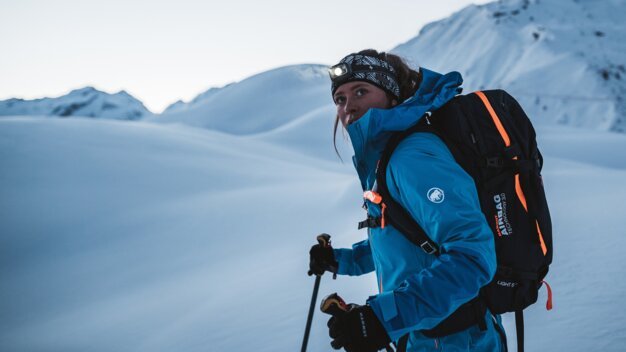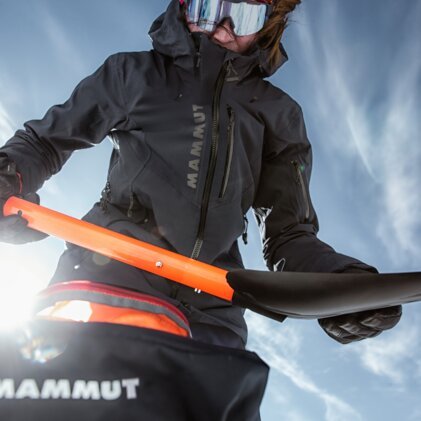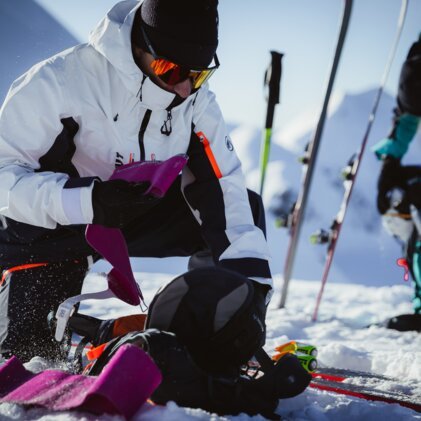
Untracked snow, unspoilt landscapes, no crowds, breathtaking views: In winter, skiing or a tour in the backcountry has many advantages. But there is also one major disadvantage: The danger of avalanches.
Studies have shown that an avalanche airbag can significantly increase the chances of surviving an avalanche. So what should you know about these potential lifesavers? What makes a good avalanche backpack and how does it work?
Together with the professionals from Mammut, we have put together some useful facts about avalanche rescue backpacks and their benefits for you.
Airbag backpack: How it works in the event of avalanche
An avalanche airbag is a safety system that is integrated into special packs that can save lives. The airbag system basically consists of a large balloon that inflates within three seconds when a cord or handle is pulled. This rapid inflation function is based on an integrated pressurised gas tank and significantly increases the total volume of the person wearing this gear. This keeps you as close to the snow surface as possible and reduces the chance of being completely buried by an avalanche.
The protective effect of the airbag backpack: The "Brazil Nut Effect".
The protective effect of the avalanche rescue pack is based on the physical principle of "inverse segregation", also known as the "Brazil Nut Effect".
This means that in a uniformly moving mass of particles, the smaller particles (= snow) are pulled down while the larger ones (= you) rise to the surface. This can be compared to a shaken packet of muesli, in which the larger nuts and sultanas floating to the top.
Avalanche backpacks work on the same principle:
- Smaller particles (snow) are pulled downwards
- Larger objects automatically rise to the surface
- The inflated airbag increases your volume in a targeted manner
- Your increased volume automatically strives upwards
- The burial depth is significantly reduced
The airbag turns you into a large Brazil nut in an avalanche.
Important: An avalanche rescue pack only provides protection if it is worn correctly and activated in time. Modern systems such as the Mammut Flip Removable Airbag 3.0 can significantly increase your chances of survival in the event of an avalanche during your tour - but they are no substitute for the necessary caution and experience in the backcountry.
Summary of advantages of backpacks with avalanche airbags:
- Odds of survival: Studies show that a backpack with an airbag can increase the chances of surviving an avalanche by 50 %.
- Protective effect: The added protection to the head and upper body reduces injuries caused by hard impacts in the snow.
- Faster recovery by rescue teams: People who can be seen more quickly can be rescued faster, reducing search times by up to 60 %.
Different types of avalanche rescue backpacks
Choosing the right avalanche airbag system is crucial for your safety on the mountain. Each system has its own specific advantages and disadvantages, which must be weighed up depending on the area of use and personal preferences.
There are basically three main types of airbag systems:
Systems by type:
Integrated systems
- Combined harness, backpack and airbag system
- Fixed volume pack compartment
- Compact system
Base unit systems
- Special backpack and harness with an integrated airbag
- Flexible attachment of pockets of different sizes using zip fasteners (zip-on systems)
- Perfect for variable needs
Removable systems
- Completely removable inflation system with tubes and airbag
- Compatible with various avalanche backpack models
- Maximum flexibility for different winter activities
Differentiation according to airbag design:
| Feature | Mono airbags | Dual airbags |
|---|---|---|
| Protected area | Head and upper body | Head, back and sides |
| Functionality | Top of backpack inflates | Side airbags |
| Advantage | Lightweight & compact | Maximum all-round protection |
| Weight | Very light | Light |
| Use | Moderate freeride and ski touring | Skiing adventures with extreme conditions and high protection requirements |
| Modularity | Flexible integration | Firmly connected |
| Example product | Mammut Removable Airbag 3.0 | Mammut Protection Airbag 3.0 |
There are also different types of cartridges and activation mechanisms.
Our tip: Mammut offers a range of backpacks with modular airbag systems that are specially designed for freeride and ski touring. These are ideal for comprehensive avalanche equipment. The reliable Airbag System 3.0 is extremely small, lightweight and versatile, so it can be integrated into various backpacks as an aid.
How do you activate the avalanche airbag?
Every rescue pack works differently, so it is important to read the instructions carefully. After all, in the event of an avalanche during your freeride and ski touring adventures, you need to deploy the airbag as quickly and efficiently as possible.
If you practise deploying the airbag in a controlled environment, you will have a better idea of what to expect.
- How hard do you have to squeeze the trigger to activate the airbag?
- What is the sound like?
- How long does it take for the airbag to inflate?
It is therefore important to carry out regular trigger tests so that you know what to do in an emergency. Our recommendation: Before the start of each winter ski season, do at least one "dry run" with the rest of your equipment, such as an avalanche probe, an and a shovel!
Fortunately, Mammut rescue systems make it very easy to carry out a practice mission. So that you don't have to refold your airbag after every practice, you can carry out a test deployment without a pressure cartridge using the trigger test tool provided.
Practice deployment of a Mammut avalanche airbag
- Screw the trigger test tool into the trigger mechanism as far as it will go.
- Put on the backpack.
- Deploy the airbag.
- Then unscrew the activation test tool from the trigger mechanism.
Travelling with an avalanche airbag
Are you planning a freeride trip or some off-piste skiing abroad? Great! But don't forget that travelling by plane with an airbag backpack requires a little extra preparation.
The good news:
- In general, all Mammut and Snowpulse airbag models can be used for flying.
The disadvantage:
- The pressurised cartridges used in the avalanche packs are considered dangerous goods, so there are special regulations for carrying them on board an aircraft.
If you need more detailed information on this topic, read our article on travelling by plane with an avalanche airbag or get advice in one of our 800 INTERSPORT Rent shops before your next tour!
To give you an overview, here are some facts about the IATA regulations:
- Only 1 avalanche airbag and 1 cartridge per person.
- The pressurised cartridge must be filled with class 2.2 gas.
- The pressure cartridge must not be transported separately from the avalanche airbag.
- Accidental activation must be prevented.
- The airbag must be equipped with a pressure release valve.
Avalanche airbag Maintenance – care, inspection and storage
To ensure that your avalanche backpack has a long service life, it must be properly cared for and maintained. Here are some useful tips on how to keep your Mammut avalanche backpack in optimum condition:
- Clean only with water.
- Do not use solvents.
- Dry it completely before using it again.
- Do not dry it in direct sunlight.
- Do not use a tumble dryer or a radiator for drying.
As well as looking after your avalanche backpack, you should also make sure that the rest of your gear, such as your helmet, avalanche transceiver and avalanche shovel, is in perfect condition. On longer freeride trips in the backcountry, it is advisable to check everything regularly.
Have you checked your avalanche rescue backpack?
If your Airbag backpack has been used in an avalanche, have it checked for damage by a dealer or specialist in your area!
Tip: For professional maintenance and help with checking your system, you can have your airbag backpack inspected at an INTERSPORT Rent shop.
Would you like to store your avalanche airbag over the summer? Simply remove the cartridge and store it together with your rucksack in a cool, dry place!
Your new avalanche backpack – buying checklist
Airbag system:
- Do you want a fixed, modular or detachable system? Choose your new model according to your flexibility, planned trip and area of use.
Compatibility:
- Consider compatibility and whether you need a fixed volume pack or a product with interchangeable pockets. An avalanche backpack with a zip-on system, such as the Mammut Base Unit, gives you the flexibility to adapt the volume to the length of your trip in the backcountry.
Cartridge:
- Check the compatibility of the cartridge and whether it is easy to refill. Make sure the cartridge is suitable for your new backpack model.
Backpack volume:
- Think about how much storage space you need. For day trips or a short ski tour in the backcountry, 20-30 litres is often enough. For a longer trip or a multi-day winter adventure, choose an airbag backpack with 30-40 litres.
Fit and comfort:
- Your new backpack should fit snugly on your back and have adjustable shoulder straps, hip straps and a chest strap. Try out different products to find the best fit.
Usage:
- A model with a dual airbag is recommended for freerides and extreme conditions, while a mono airbag system is often sufficient for a moderate tour in the backcountry.
Maintenance and care:
- Make sure that your product is easy to clean and made from durable materials that can withstand adverse weather conditions.
Value for money:
- Consider not only the price of the backpack, but also the running costs, e.g. for cartridges.
Extras:
- Many avalanche packs come with useful extras such as helmet straps, space for an avalanche shovel and hydration system compatibility.
Do you need help choosing the perfect avalanche airbag? Visit our experts at INTERSPORT Rent for personal advice and more information!
What else does basic avalanche equipment include?
Although an avalanche backpack can significantly increase your chances of survival in an avalanche, it is not a complete guarantee. Its effectiveness depends on a number of other factors. That's why you should always take a complete safety kit with you on the mountain. This consists of ...
- ... an avalanche transceiver (e.g. Barryvox® from Mammut),
- ... an avalanche probe and
- ... an avalanche shovel.
Don't forget: Skilful use of avalanche equipment takes practice. Practise regularly with your gear and take in an avalanche safety course!
Frequently asked questions about avalanche airbags:
When should the avalanche airbag be activated?
An avalanche airbag should be activated as soon as you are caught in an avalanche or realise that an avalanche is imminent. Pulling the activation handle will inflate the airbag within 2 to 3 seconds and increase its volume, reducing the chance of being completely buried.
What size avalanche backpack is right for you?
The optimum size of an avalanche backpack depends on the type and duration of your tours. Backpacks with a volume of around 20 to 30 litres are suitable for day trips, as they provide enough space for the necessary equipment. For trips lasting several days or if you are carrying additional equipment, backpacks with a volume of 30 to 40 litres can be useful. It is important that the pack offers enough storage space for your individual equipment without being too large or heavy.
How much does an avalanche airbag weigh?
The weight of an avalanche backpack varies depending on the model and features. Modern avalanche backpacks generally weigh between 1.5 kg and 3.0 kg. Lighter products often have less additional functions, while more fully featured backpacks can weigh correspondingly more. It is important to choose a product that provides a good balance between weight and functionality to ensure comfort and safety.
Are avalanche backpacks re-usable?
Yes, avalanche backpacks can be re-used. However, after a deployment, the gas cartridge or battery of the airbag system must be replaced or recharged according to the manufacturer's instructions. Some systems allow the airbag to be stowed away automatically after use and the cartridge to be replaced or refilled. It is important to follow the manufacturer's specific instructions to ensure the full functionality and safety of the backpack after deployment
INTERSPORT Rent tip
If you're new to freeriding or have any questions about safety in the mountains, pop into one of our 800 INTERSPORT Rent locations!
The local RENTertainers know what to look out for in the mountains and will be happy to answer all your questions. You can also choose from a wide range of rental equipment suitable for both groomed and off-piste adventures.








